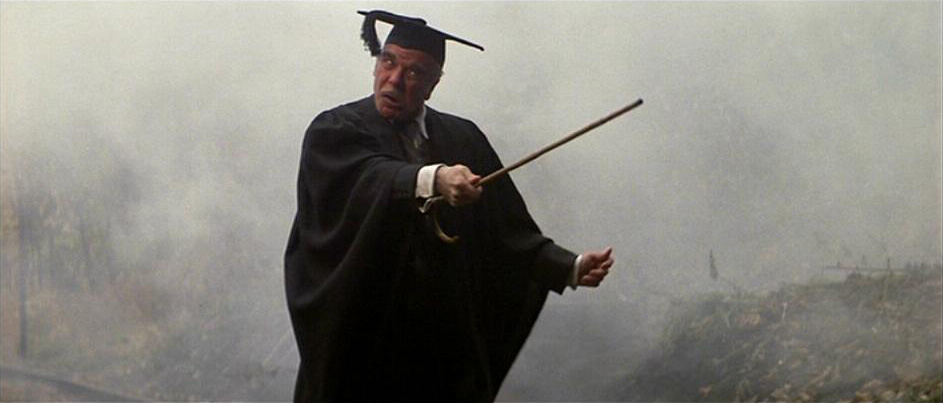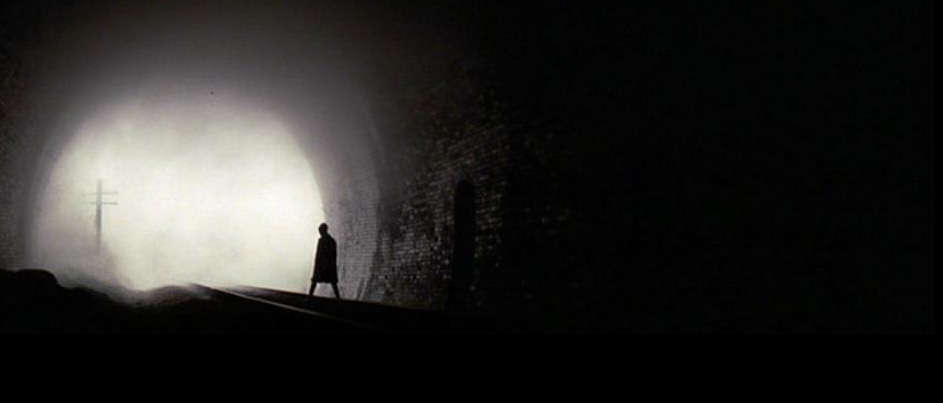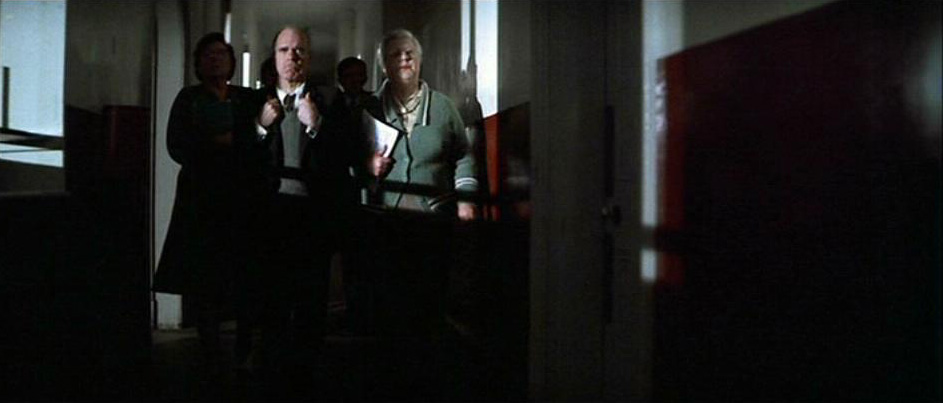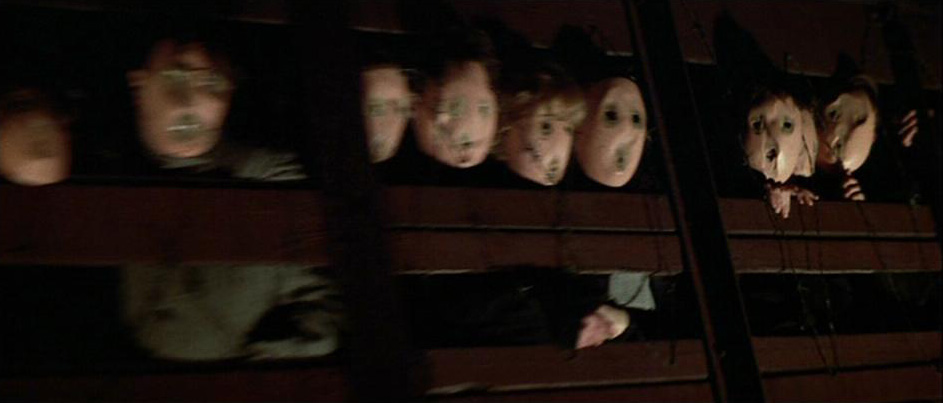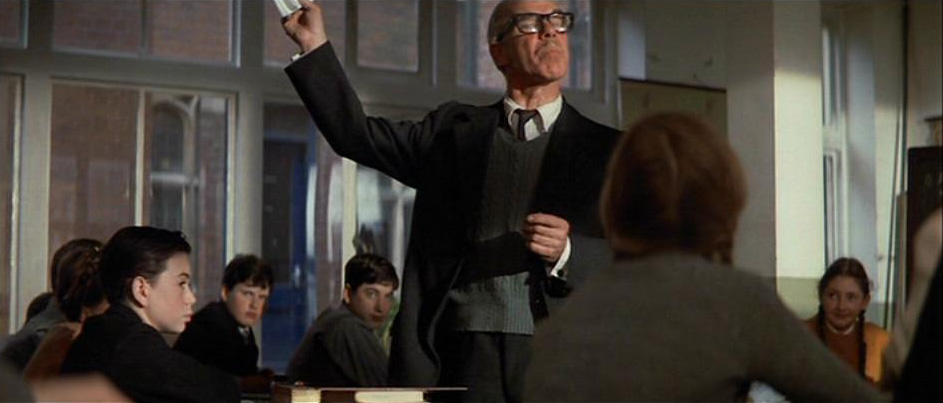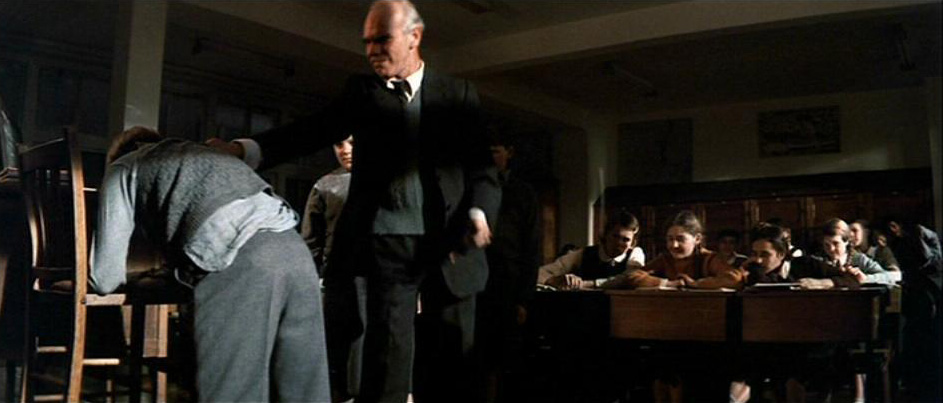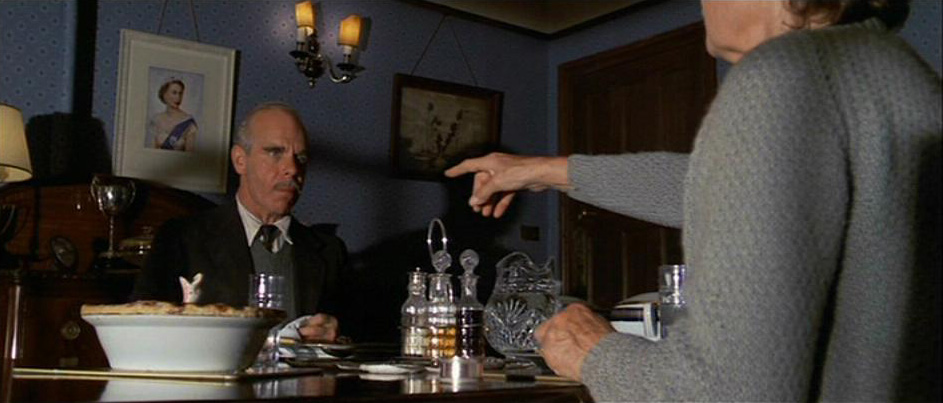The Happiest Days Of Our Lives
[Roger Waters]When we grew up and went to school
There were certain teachers who would
Hurt the children in any way they could
By pouring their derision upon anything we did
And exposing every weakness
However carefully hidden by the kids
But in the town, it was well known
When they got home at night, their fat and
Psychopathic wives would thrash them
Within inches of their lives.
Song In A Sentence:
Pink recounts how the teachers of his childhood would stop at nothing to eradicate individuality and humiliate their students, imagining, with bitter satisfaction, how the teachers would get their own karmic comeuppance when they got home.
F or good or bad, no childhood retrospective would be complete without devoting some time to that system which stretches over literal decades of a person’s formative years: Education. Like so many of the Wall’s songs, “the Happiest Days of Our Lives” and the subsequent “Another Brick in the Wall, Part 2” serve as more bricks, detailing the injustices of what Pink portrays as a personally stifling social system. Yet unlike so many of the bricks found in other songs, the one formed in “Happiest Days” has a slightly uplifting note of Karmic retribution – at least for Pink – injecting a bit of comic irony into what is, for the most part, a symbolically oppresive album. Let me note at the outset, though, that neither “the Happiest Days of Our Lives” nor the following “Another Brick in the Wall, Part 2” are blanket condemnations against all educational systems. As with any institution there are good and bad members – those who truly care about what they are doing and those who take out their aggressions on the innocent. Waters commented in an interview that this song refers to those bad teachers who continually put their students down, never encourage or motivate them, and simply try to “crush them into the right shape, so that they would go to university and ‘do well'” (Waters, DVD commentary).
Coming off the repetitive guitar riff of “Another Brick in the Wall, Part 1” on the album, the helicopter sound effect and barked orders from the megaphone take up the authoritarian themes laid out in the previous song. It’s somewhat strange to think that Pink introduces us to his teacher (or perhaps a sort of amalgamation of all the teachers he had throughout his school career) via the helicopter and megaphone, sound effects that one wouldn’t normally associate with any school. However, the overall military effect is spot on, with the teacher hovering over his pupils, helicopter-like, waiting to come down on them with the wrath of a military drill sergeant should any of them even think of stepping out of line. Even the command yelled through the megaphone for some student to “stand still, laddie!” is drill-sergeant-like, establishing both what Pink (and Waters) saw to be the militaristic rule of the post-War British school system as well as the symbol of the obedient, faceless drones that the system endeavored to produce…all before the song proper even begins.
The repetitive guitar picking style of “Happiest Days” provides a further connection with “Another Brick in the Wall, Part 1,” though here Waters’ brooding bass guitar adds another layer of acrimony that was missing from the previous song. One can almost hear Pink growing older and more jaded in the music, trusting less and less the familial and social systems that shape his life. Waters’ taciturn vocals in the first half of the song add to the sinister effect created by the lyrics, delivered much like a schoolboy conspiratorially whispering to his friends in the schoolyard. The lyrics themselves are fairly straightforward, telling about those “certain teachers” who would stop at nothing in order to break the children of their individuality, thus forcing them into a voiceless, faceless mold of “productive citizens” (Waters, DVD commentary). Rather than educate and enlighten, Pink portrays a system that hurts, derides and exposes. As a result, the children erect wall-like defenses to guard their personal and intellectual weaknesses from the teachers for fear that, rather than addressing these “carefully hidden” weaknesses in a productive manner, the teachers will only use them for ridicule. It’s with sheer glee that Pink sings of the common knowledge that these very same abusers are equally abused when they go home to their “fat and psychopathic wives” who verbally (and perhaps physically) “thrash them within inches of their lives.”
For all thematic cycles we’ve seen thus far in the album, “Happiest Days” is arguably the first that directly alludes to Karma, the idea that all actions and deeds are cyclical, with the net positive or negative effect of those actions being revisted upon their author. Simply put, Karma at its most basic level suggests that if you do good, you reap good things; if you do bad, well, there will eventually be equally negative consequences. It is very much a philosophy of cause and effect that ultimately teaches that everyone is responsible for their own actions. In “Happiest Days,” Pink gets a taste of this Karmic retribution, breaking out into an almost religious chorus of Hallelujahs at the end of the song after he recounts how the punishment his teacher doles out by day is revisited upon him at night. Later in the album, however, he’ll learn first hand about the cyclical nature of cause and effect as the negative consequences of his own actions finally catch up to him.
Although the song ends on a fairly triumphant note, there are darker shades to the small victory in which Pink relishes. Satisfying though it is to hear the teacher get what he deserves, the Karmic cycle presented is still as disastrous as any other encountered in the album. With what we already know about Pink’s adult self, one can’t help but draw parallels between the older Pink and his former teacher; in many respects, both are simply redirecting their personal pain and emptiness onto the undeserving people in their lives. The teacher – no doubt himself molded into his present state by his own oppressive childhood education – visits his personal unhappiness on the children, goes home to an unfulfilling marraige where he himself feels abused, then goes back to school to redirect that dissatisfaction back onto the children. Nor do these instances of abuse end with him; the torment that he doles out will undoubtedly influence other children, who will in turn mete that same pain onto the next generation. And so the cycle continues, unabated. Like Pink later in life, the teacher has the power to interrupt this violent cycle, yet he is so entrenched behind his own wall that he chooses to defend his position and redirect the pain of life back into the world. Unfortunately, while he is defending his wall, the teacher inadvertently provides some of the bricks for the walls of his students, educating them perhaps best of all on how to alienate themselves from their emotions and the rest of the world.
Mirroring the dual interpretations of the ending – straightforward, Karmic triumph couched within an ironic cycle of injustice – is the very title of the song itself. When considered in the context of this lyrics alone, one would rightly assume that “the Happiest Days of Our Lives” is a sarcastic reference to the nostalgic idea that childhood should be the happiest time of anyone’s life, that time well before one has to take a mindless 9 to 5 job, well before bills, car payments, a mortgage, relationship problems, the very weight of the world settled on one’s shoulders. The reality as Waters presents it, however, is that childhood can be full of hurt, disillusionment, fear, guarded emotions, and self-doubt. It can be just as emotionally fraught as any point in adulthood. The flipside of that interpretation is that, already knowning what we do about Pink, perhaps these truly were the happiest days of his life and he just didn’t know it until now, in his fractured present. It could be that everything his teacher inadvertently taught him through shame and humiliation was a mild precursor to all that would follow, in which case “Happiness,” like most everything else in the modern world, is completely relative.
The accompanying movie scenes perfectly highlight Pink Floyd’s ability to meld the everyday with a heightened sense of emotional reality. A perfect example is the sequence of film before the song actually starts when Pink and two friends lay the bullets he found in the dresser drawer from “When the Tigers Broke Free, Part 2” on some railroad tracks, watching them explode as the passing train ignites the ammunition. Backed against the tunnel wall, the explosion of his bullet causes Pink to imagine both the train cars as being packed with faceless people and his school teacher at the other end of the tunnel yelling for him to “stand still, laddie!” The transition between external reality and Pink’s imaginings is so seamless and void of any transitional clues that the viewer (and perhaps Pink himself) is a bit perplexed as to the reality of the horrific train procession. The effect of such blurring between fantasy and reality creates a bond between the viewer and Pink – we experience firsthand what Pink alone has seen and so can feel his confusion – but it also reminds us to stay on our toes, to be wary of accepting the story as an undeviating narrative. What appears to be “real” on the screen may be the most fantastical conjuring of Pink’s splintering mind. While the hallucinatory aspect of this example is fairly obvious, other instances further in the film are far less discernible and, if taken as reality, will no doubt throw the viewer into a state of confusion similar to Pink’s own. This film segment is merely a stepping stone, in a sense; it is something that reminds us as the viewer that not everything we will see is real and that in order to make sense of the story, we must be able to “claw through the disguise.”
Another interesting aspect about this pre-song scene is the blatant parallel between the faceless passengers in the train (presumably school children as evidenced in the next song as well as the brief mask seen on Pink between the passing train cars) and the millions of “faceless” Jews transported to concentration camps during World War II. While it’s absurd to think that Waters is suggesting that the plight of oppressed school children is equivalent the deaths of millions of Jews, he is perhaps suggesting that both institutions (certain schools / concentration camps) were machines that sought to repress all “participants” and rob them of their human rights and individuality. With just roughly cut out eyes and mouths, the mask-people are rendered into things rather than people with recognizable human qualities. Fear and hate-based systems operate largely in this way, robbing people of their identities in order to break that people’s spirit as well as to turn others against them. By this reading, the school master at the end of the tunnel takes on a greater weight as a cog in the totalitarian machine whose sole intent is to force the teeming masses of youth into a unified mold void of personal identity. And just as the soldiers march into the consuming fog of self-erasure in “the Thin Ice,” Pink begins to walk out of the tunnel into the smoke left by the train as the song begins, paralleling his own certain loss of identity as he enters the memories of his school days.
Directly following the tunnel scene, the viewer glimpses the faculty lounge of the school where the teachers are preparing for class. After the morning bell rings, each teacher stands and adjusts his or her garments, as if straightening a military uniform in preparation for war. They exit the room in single file and, in military style, march down the hallway in two columns with Pink’s teacher in the lead as the “commanding officer,” so to speak. An often overlooked tidbit is the color scheme of the walls in the hallway. The white top half of the wall and the red bottom half mirror the color scheme of the crossed-hammer insignia in Pink’s later dictatorial dementia. It’s also interesting to note that white is generally the symbolic color of innocence and red the color of blood and sin. Mixing the two together, red and white…sin and innocence…results in the color Pink.
In the next scene, the teacher discovers Pink writing poems and disciplines him by reading the poem aloud, to much laughter from Pink’s peers, before a quick slap on the hand with a ruler. Never ones to shy away from self-reference, the “poem” that Pink is writing is actually from Pink Floyd’s song “Money,” used here to possibly blur the lines of autobiography and fiction, to suggest early on Pink’s aspirations to be rich and famous, and to foreshadow his future success as a rock star. Little time is wasted on Pink’s display of individuality, and the teacher automatically resumes the rote Geometry lesson, pounding the definitions into the heads of the children by means of constant repetition. This “learning” is very similar to the “hypnopedia” of Aldous Huxley’s A Brave New World in which lessons are repeated to sleeping infants by a machine so that, after hearing the lesson countless times in their sleep, the young children will accept the formulas as fact. Such subtle brainwashing in Huxley’s novel, much like the techniques used by Pink’s teacher to mold the children into “proper members of society,” results in a strictly enforced caste system and shapes the bio-engineered children into the “model” citizens. (More on Huxley and the Wall in the analysis for “Goodbye Blue Sky.”)
The exultation in Waters’ voice recalling the rumored nightly punishment of his teacher is reflected in the following scenes depicting the teacher eating supper with his wife. Though the wife is not physically overweight as the lyrics suggest, the low camera angles cause her to fill up half the screen, visually portraying her as a very domineering presence. The room cluttered with pictures and other minutiae of home life; the larger-than-life shadows on the wall; the vibrant blue wall paper and purple light in the window behind the wife; all contribute to the surrealistic, slightly-skewed atmosphere of the scene, making the viewer wonder if, once again, we are seeing reality, the imagination of young Pink, or a mixture of both. In quick, successive shots we see the previously mentioned idea of Karma played out, with the teacher spanking the backsides of schoolchildren with a leather strap, alternating with his wife emasculating him by commanding him – without so much as a word! – to swallow down the hard piece of meat that he had tried to secretly spit out. At the risk of stretching the meaning of that one shot, the teacher is not allowed to continue with his meal until he eats everything on his plate, including some inconsequential piece of gristle that he spit out; in other words, as he so famously yells at the end of the following song, “you can’t have any pudding if you don’t your meat.” Because he can’t have his metaphorical dessert without first enduring the hardships of life, he will make sure that the same applies to the next generation. And the cycle rolls on.
What Other Floydians Have Said
"In 'The Happiest Days Of Our Lives' album version, after the line 'hurt the children any way they could' there is the sound of something being cracked and a voice saying 'oof!' I think that this alludes to the later question that Pink asks of his mother 'do you think they'll try to break my balls?' This would imply that society has already started / tried to break his balls and Pink is really stoically resigned to his fate, and only asking this question of his mother in what is surely vain hope rather than childlike innocence." - Dan Jone
"When the schoolmaster and the teachers are leaving their room, they walk/march in a position very similar to Pink and his 'soldiers' after his transformation right after 'Comfortably Numb.' In the second 'In the Flesh,' you said that Pink became exactly what he hated, a Nazi dictator from WWII. Couldn't he also have some influence from his teacher, who was a dictator ruling over the children? Also, this could be his first example of a dictator (since he didn't have a rigid father), so maybe he just followed the lead." - Luiz Fabiano
"Throughout the movie, (as has been noted by yourself and others) the colors white and red are used in tandem with several ideas about the meaning being attached by different observers. The simplest being 'white and red make pink.' The more involved noting the sybology of each color and its parallel in Pink's psycology. But upon watching the movie again, I noticed that everywhere red and white are represented, there is also green. From the opening scene with the white hallway, red sconces, and green keyboard pattern in the carpet, to Pink's first appearance in the baby carriage (red, white and pink flowers, green leaves and grass) to every extra I've noticed wearing any of the three also has the other two on them. Interesting. Green meaning envy, greed, jealousy?" - Dan Rau



